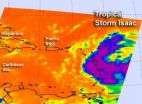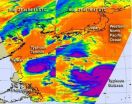(Press-News.org) New born human infants have the largest brains among primates, but also the highest proportion of body fat. Before birth, if the supply of nutrients from the mother through the placenta is limited or unbalanced, the developing baby faces a dilemma: should resources be allocated to brain growth, or to fat deposition for use as an energy reserve during the early months after birth?
Scientists at the University of Southampton have shown that this decision could have an effect on how fat we are as children.
In new research, published in the journal PLoS ONE today (22 August 2012), scientists at the Medical Research Council (MRC) Lifecourse Epidemiology Unit at the University, performed ultrasound scans on 381 pregnant women taking part in the Southampton Women's Survey. They measured the blood flow from the placenta to the unborn baby, and the distribution of this blood to either the liver of the baby or bypassing the liver to supply the brain and heart. This was then compared with the infant's body fatness at birth and at four years old.
The findings show that greater blood flow to the baby's liver in late pregnancy was associated with greater body fatness in the infant at birth and at age four. In contrast, lower liver blood flow and a "brain-sparing" blood flow pattern (when the blood bypasses the liver and goes to the brain) occurred when the placenta was smaller and less able to meet baby's demand for essential nutrients in the womb.
These findings were independent of an association between mother's body fatness and the body fatness of her infant.
Keith Godfrey, Professor of Epidemiology and Human Development, at the University who led the study, explains: "In our evolutionary past, the demands of a big brain have led the unborn baby to develop blood flow responses which preserve nutrient delivery to the brain when the supply of essential nutrients from the mother cannot meet the baby's requirements.
"However, having a big brain has also led to evolution of a strategy to adjust blood flow through the baby's liver, which enables the liver to produce more fat – this acts as an energy reserve, protecting brain development during periods of illness or under-nutrition in early infancy. Our data suggests that evolution of this strategy has brought with it a predisposition to obesity and later diabetes in contemporary societies with abundant nutrition in later postnatal life."
Professors Guttorm Haugen from the University of Oslo and Torvid Kiserud from the University of Bergen were part of the research team. They comment: "An interpretation of our findings is that there could be programmed effects on the liver that arise from blood flow adaptations in the womb and predispose individuals to gain excess body fat. Although further studies are needed, our findings add weight to current concerns that the current epidemic of childhood obesity and associated disorders may partly have its origins through adaptations made by the developing baby during pregnancy."
Professor Mark Hanson, Director of the University of Southampton's Human Development and Health Academic Unit, adds: "If the supply of nutrients across the placenta is inadequate or unbalanced, the unborn baby has to decide whether to prioritise fat deposition or spare brain growth – it does this by changing the amount of blood flowing to the liver and brain. A decision to increase blood flow to the liver has lasting implications for the child's body fatness.
"Transfer processes across the placenta for some nutrients such as glucose evolved in environments less affluent than those now prevalent in developed populations, and our findings additionally suggest that in circumstances of maternal obesity and nutrient excess these processes now also lead to excessive fat deposition in the womb."
"This strengthens the case for all women of reproductive age having greater access to nutritional, education and lifestyle support to reduce the risk of obesity in their children and improve the health of the next generation."
Professor Cyrus Cooper, Director of the MRC Lifecourse Epidemiology Unit comments: "This study is part of a wider body of work by the MRC Lifecourse Epidemiology Unit into how factors during pregnancy might have a long-term influence on childhood growth and development. This is a wonderful example of multi-disciplinary research using the unique clinical resource provided by the Southampton Women's Survey."
### END
Children's body fatness linked to decisions made in the womb
2012-08-23
ELSE PRESS RELEASES FROM THIS DATE:
Imaging study sheds new light on alcohol-related birth defects
2012-08-23
CHAPEL HILL, N.C. – A collaborative research effort by scientists at the University of North Carolina School of Medicine, Duke University, and University College of London in the UK, sheds new light on alcohol-related birth defects.
The project, led by Kathleen K. Sulik, PhD, a professor in the Department of Cell and Developmental Biology and the Bowles Center for Alcohol Studies at UNC, could help enhance how doctors diagnose birth defects caused by alcohol exposure in the womb. The findings also illustrate how the precise timing of that exposure could determine the ...
Moms linked to teen oral health, says CWRU dental study
2012-08-23
A mother's emotional health and education level during her child's earliest years influence oral health at age 14, according to a new study from Case Western Reserve University's School of Dental Medicine.
Researchers started with the oral health of the teens and worked backwards to age 3 to find out what factors in their past influenced their oral health outcomes.
While mothers were interviewed, lead investigator Suchitra Nelson, professor in the dental school, believes it can apply to whoever is the child's primary caregiver.
Nelson's team examined the teeth of 224 ...
Super-strong, high-tech material found to be toxic to aquatic animals
2012-08-23
Carbon nanotubes (CNTs) are some of the strongest materials on Earth and are used to strengthen composite materials, such as those used in high-performance tennis rackets. CNTs have potential uses in everything from medicine to electronics to construction. However, CNTs are not without risks. A joint study by the University of Missouri and United States Geological Survey found that they can be toxic to aquatic animals. The researchers urge that care be taken to prevent the release of CNTs into the environment as the materials enter mass production.
"The great promise ...
Nematodes with pest-fighting potential identified
2012-08-23
This press release is available in Spanish.
Formosan subterranean termites could be in for a real headache. U.S. Department of Agriculture (USDA) scientists have identified species of roundworms, or "nematodes," that invade the termite brains and offer a potential bio-based approach to controlling them. Other nematodes that were identified invaded tarantula brains.
The Formosan termite, a nonnative species from Asia, feeds on cellulose from the heartwood of trees, the wood support beams of buildings, and other sources. It causes an estimated $1 billion annually in ...
Cramming for a test? Don't do it, say UCLA researchers
2012-08-23
Every high school kid has done it: putting off studying for that exam until the last minute, then pulling a caffeine-fueled all-nighter in an attempt to cram as much information into their heads as they can.
Now, new research at UCLA says don't bother.
The problem is the trade-off between study and sleep. Studying, of course, is a key contributor to academic achievement, but what students may fail to appreciate is that adequate sleep is also important for academics, researchers say.
In the study, UCLA professor of psychiatry Andrew J. Fuligni, UCLA graduate ...
NASA sees Tropical Storm Isaac and Tropical Depression 10 racing in Atlantic
2012-08-23
VIDEO:
This animation of satellite observations from August 19-22, 2012, shows the development and movement of Tropical Storm Isaac toward the Lesser Antilles. This visualization was created by the NASA GOES...
Click here for more information.
There are now two active tropical cyclones in the Atlantic and NASA is generating satellite imagery to monitor their march westward. Tropical Storm Issac is already bringing rainfall to the Lesser Antilles today, Aug. 22, Tropical ...
University of Colorado analysis of election factors points to Romney win
2012-08-23
A University of Colorado analysis of state-by-state factors leading to the Electoral College selection of every U.S. president since 1980 forecasts that the 2012 winner will be Mitt Romney.
The key is the economy, say political science professors Kenneth Bickers of CU-Boulder and Michael Berry of CU Denver. Their prediction model stresses economic data from the 50 states and the District of Columbia, including both state and national unemployment figures as well as changes in real per capita income, among other factors.
"Based on our forecasting model, it becomes clear ...
Double trouble continues in the Philippine Sea: Tembin and Bolaven
2012-08-23
Typhoon Tembin and Typhoon Bolaven continue to churn in the Philippine Sea, and infrared satellite data from NASA showed the power within both storms.
The Atmospheric Infrared Sounder (AIRS) instrument that flies onboard NASA's Aqua satellite captured imagery of both storms on Aug. 21 in two different overpasses. Aqua flies over the same locations during early morning and early afternoon (local time) as it orbits the Earth. Aqua passed over the Philippine Sea on Aug. 21 at 04:41 UTC (12:41 a.m. EDT) and 16:47 UTC (12:47 p.m. EDT). The two satellite passes were combined ...
Scientists from UCLA, Israel's Technion uncover brain's code for pronouncing vowels
2012-08-23
Scientists at UCLA and the Technion, Israel's Institute of Technology, have unraveled how our brain cells encode the pronunciation of individual vowels in speech.
Published in the Aug. 21 edition of the journal Nature Communications, the discovery could lead to new technology that verbalizes the unspoken words of people paralyzed by injury or disease.
"We know that brain cells fire in a predictable way before we move our bodies," said Dr. Itzhak Fried, a professor of neurosurgery at the David Geffen School of Medicine at UCLA. "We hypothesized that neurons would ...
Video shows the traffic inside a brain cell
2012-08-23
Using bioluminescent proteins from a jellyfish, a team of scientists has lit up the inside of a neuron, capturing spectacular video footage that shows the movement of proteins throughout the cell.
The video offers a rare peek at how proteins, the brain's building blocks, are directed through neurons to renew its structure. It can be viewed online here: http://www.youtube.com/watch?v=baI9q2--q7s&feature=youtu.be
"Your brain is being disassembled and reassembled every day," said Don Arnold, associate professor of molecular and computational biology at the USC Dornsife ...


